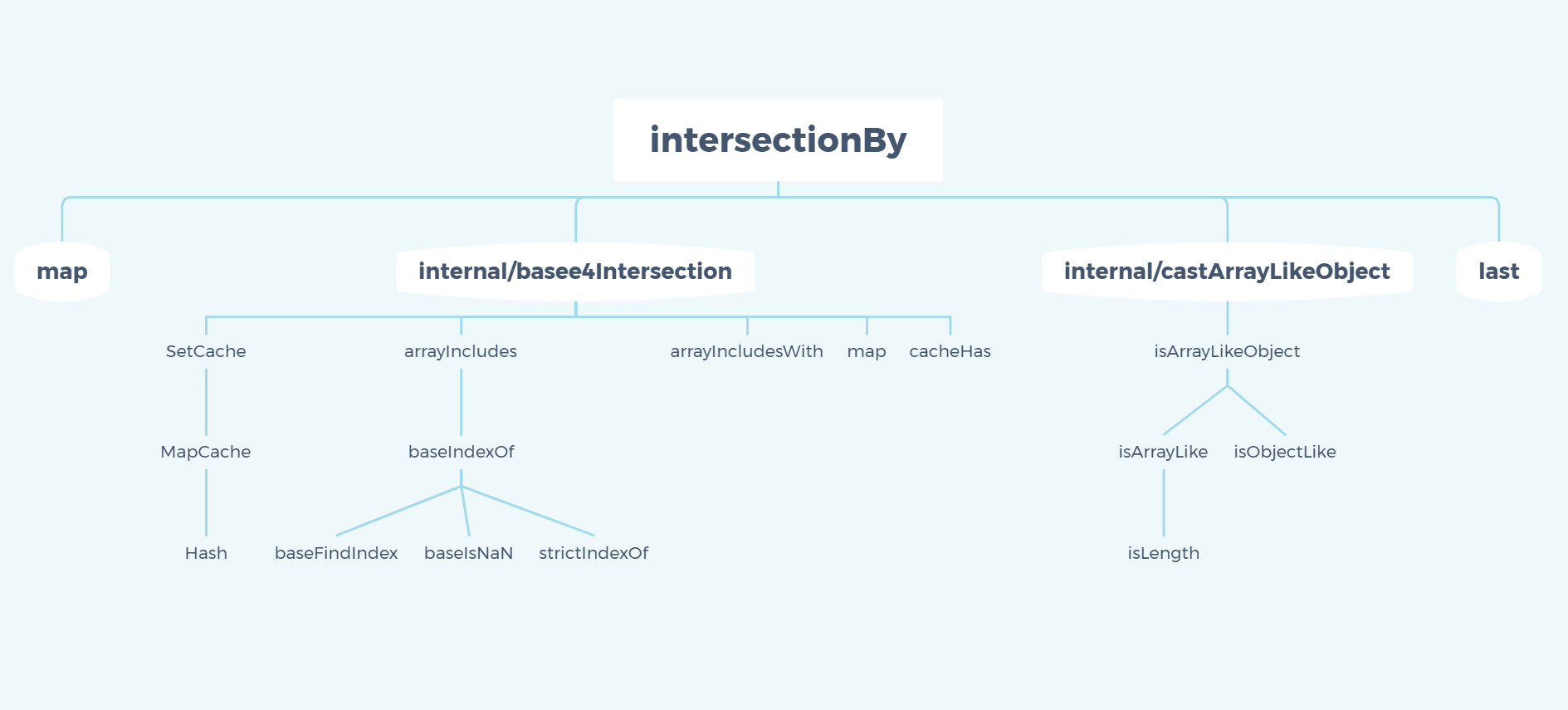A modern JavaScript utility library delivering modularity, performance & extras.
lodash是一个一致性、模块化、高性能的JavaScript实用工具库
# 一、环境准备
lodash版本v4.0.0通过
github1s网页可以 查看 (opens new window)lodash - intersectionBy源码调试测试用例可以
clone到本地
git clone https://github.com/lodash/lodash.git
cd axios
npm install
npm run test
# 二、结构分析

这是一张 intersectionBy 依赖引用路径图,相对复杂一些,按照功能划分,大致包括baseIntersection 模块、castArrayLikeObject模块。但其中大部分内容已在lodash-intersection源码研读解析、lodash-baseIntersection源码研读解析,两篇文章中讲述,现在不再赘述,仅对 baseIntersection、castArrayLikeObject、以及intersectionBy 主体做一下说明。
# 三、函数研读
# 1. map 模块
创建一个数组, value(值) 是 iteratee(迭代函数)遍历 collection(集合)中的每个元素后返回的结果。 iteratee(迭代函数)调用3个参数(value, index|key, collection)
/**
* @since 5.0.0
* @category Array
* @param {Array} array 用来迭代的集合
* @param {Function} iteratee 每次迭代调用的函数
* @returns {Array} 返回新的映射后数组
* @example
*
* function square(n) {
* return n * n
* }
*
* map([4, 8], square)
* // => [16, 64]
*/
function map(array, iteratee) {
let index = -1
const length = array == null ? 0 : array.length
const result = new Array(length)
while (++index < length) {
result[index] = iteratee(array[index], index, array)
}
return result
}
export default map
- 使用
new Array创建一个对应其长度的数组result,其中array为null时,长度为0,将会创建一个空数组 - 按照
array长度循环调用iteratee,每次循环步长 + 1, - lodash规定了一些内部关键词不可用于对
iteratee命名,如every、fill等,关于map的使用规则参见Lodash 文档 - map (opens new window)
# 2. last
Array 类型的一个方法,目的是获取数组最后一个元素
/**
* @since 0.1.0
* @category Array
* @param {Array} array 要检索的数组
* @returns {*} 返回array中的最后一个元素
* @example
*
* last([1, 2, 3])
* // => 3
*/
function last(array) {
const length = array == null ? 0 : array.length
return length ? array[length - 1] : undefined
}
export default last
- 如果
array为null则返回undefined否则取array最后一位
# 3. castArrayLikeObject 模块
如果不是类数组对象,则将“value”强制转换为空数组
import isArrayLikeObject from '../isArrayLikeObject.js'
/**
* @private
* @param {*} value 要检查的值
* @returns {Array|Object} 返回类似于cast数组的对象
*/
function castArrayLikeObject(value) {
return isArrayLikeObject(value) ? value : []
}
export default castArrayLikeObject
- 封装了
isArrayLikeObject,当value同时符合isArrayLikeObject所检测的目标类型时返回true,此时返回value,否则返回空数组
# 4. baseIntersection 模块
“intersection”之类的方法的基本实现,接受要检查的数组
import SetCache from './SetCache.js'
import arrayIncludes from './arrayIncludes.js'
import arrayIncludesWith from './arrayIncludesWith.js'
import map from '../map.js'
import cacheHas from './cacheHas.js'
/**
* @private
* @param {Array} arrays 要检查的阵列
* @param {Function} [iteratee] 每个元素调用的迭代对象
* @param {Function} [comparator] 每个元素调用的比较器
* @returns {Array} 返回共享值的新数组
*/
function baseIntersection(arrays, iteratee, comparator) {
const includes = comparator ? arrayIncludesWith : arrayIncludes
const length = arrays[0].length
const othLength = arrays.length
const caches = new Array(othLength)
const result = []
let array
let maxLength = Infinity
let othIndex = othLength
while (othIndex--) {
array = arrays[othIndex]
if (othIndex && iteratee) {
array = map(array, (value) => iteratee(value))
}
maxLength = Math.min(array.length, maxLength)
caches[othIndex] = !comparator && (iteratee || (length >= 120 && array.length >= 120))
? new SetCache(othIndex && array)
: undefined
}
array = arrays[0]
let index = -1
const seen = caches[0]
outer:
while (++index < length && result.length < maxLength) {
let value = array[index]
const computed = iteratee ? iteratee(value) : value
value = (comparator || value !== 0) ? value : 0
if (!(seen
? cacheHas(seen, computed)
: includes(result, computed, comparator)
)) {
othIndex = othLength
while (--othIndex) {
const cache = caches[othIndex]
if (!(cache
? cacheHas(cache, computed)
: includes(arrays[othIndex], computed, comparator))
) {
continue outer
}
}
if (seen) {
seen.push(computed)
}
result.push(value)
}
}
return result
}
export default baseIntersection
- 如果有比较器
comparator则使用比较器查找,否则使用默认查找方法baseIndexOf - 要检查的
array过长(length > 120)时使用caches做缓存 outer执行多层嵌套语句
# 5. intersectionBy 模块
这个方法类似_.intersection,区别是它接受一个 iteratee 调用每一个arrays的每个值以产生一个值,通过产生的值进行了比较。结果值是从第一数组中选择。iteratee 会传入一个参数:(value)
import map from './map.js'
import baseIntersection from './.internal/baseIntersection.js'
import castArrayLikeObject from './.internal/castArrayLikeObject.js'
import last from './last.js'
/**
* @since 4.0.0
* @category Array
* @param {...Array} [arrays] 待检查的数组
* @param {Function} iteratee iteratee(迭代器)调用每个元素
* @returns {Array} 返回一个包含所有传入数组交集元素的新数组
* @example
*
* intersectionBy([2.1, 1.2], [2.3, 3.4], Math.floor)
* // => [2.1]
*/
function intersectionBy(...arrays) {
let iteratee = last(arrays)
const mapped = map(arrays, castArrayLikeObject)
if (iteratee === last(mapped)) {
iteratee = undefined
} else {
mapped.pop()
}
return (mapped.length && mapped[0] === arrays[0])
? baseIntersection(mapped, iteratee)
: []
}
export default intersectionBy
- 与
intersection不同的是intersectionBy最后一位是传入的迭代器iteratee,所以需要使用last获取iteratee,但需要注意的是最后一位有可能并不是合法的iteratee - 使用
map配合迭代器castArrayLikeObject检测入参arrays是否是合法数组,返回mapped - 使用
last获取mapped最后一位,并与iteratee做对比,当iteratee不合法(在isLikeObject中使用typeof判断为function类型返回为空,从而mapped最后一项为空)取undefined否则弹出最后一位(此时最后一位为iteratee,为非处理数据) - 如
mapped存在并且入参第一项arrays是合法数组,则调用baseIntersection检测公共元素,否则返回空数组
